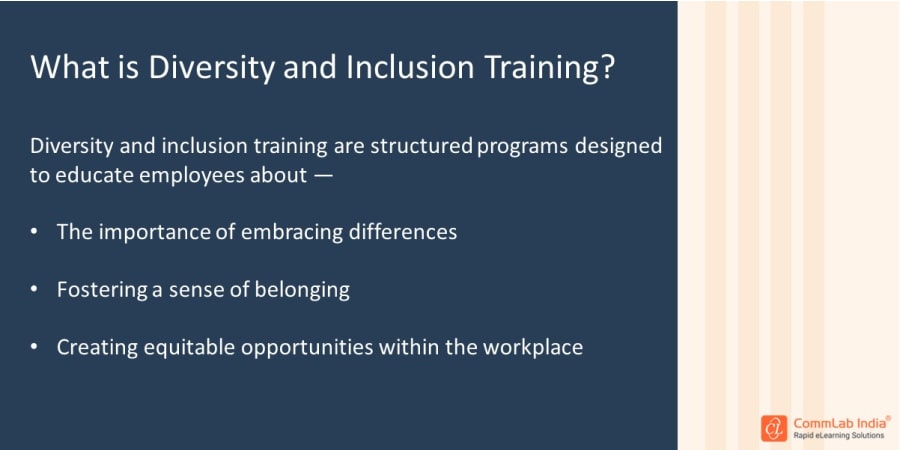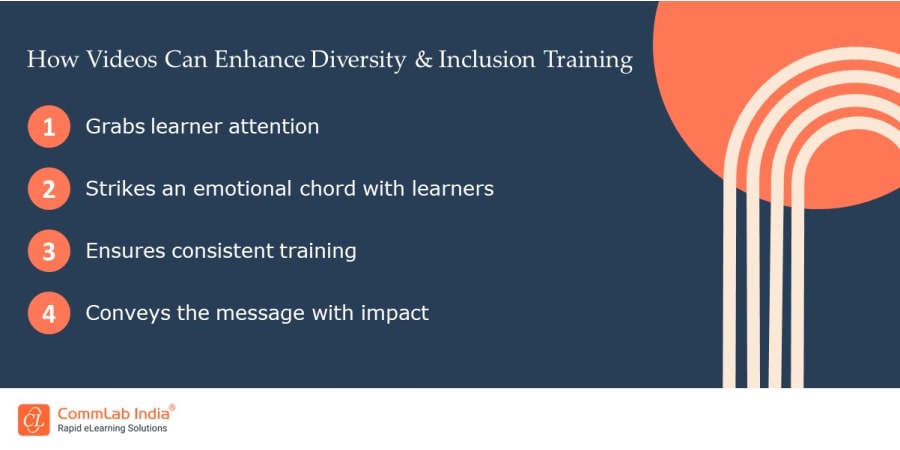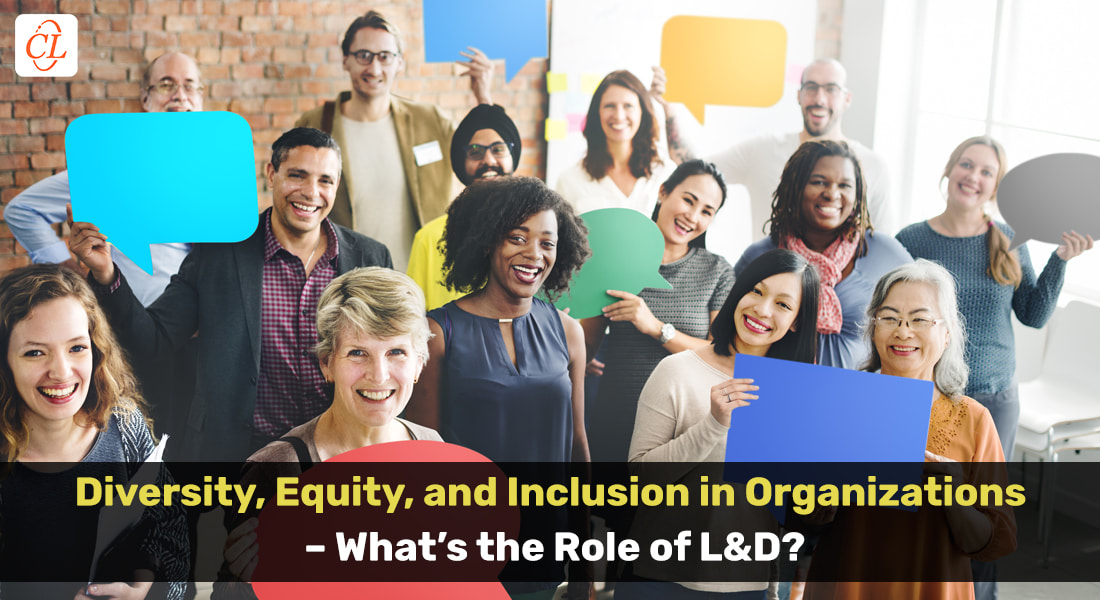5 Effective Diversity and Inclusion Training Strategies for Modern Workplaces

Let’s admit it! In today's globalized business landscape, diversity and inclusion have emerged as crucial elements for organizational success. As companies expand their reach across borders and cultures, fostering a diverse and inclusive workplace becomes not just a moral imperative but also a strategic advantage. To achieve this, organizations are increasingly turning to diversity and inclusion training. In this blog, we will delve into what diversity and inclusion training entails, why it is essential, and outline five effective strategies for implementing such training in modern workplaces.
Let’s Understand — What is Diversity and Inclusion Training?

Diversity and inclusion training are structured programs designed to educate employees about the importance of embracing differences, fostering a sense of belonging, and creating equitable opportunities within the workplace. These programs go beyond mere compliance with diversity policies; they aim to cultivate a culture where every individual feels valued, respected, and empowered to contribute their best.
Diversity and inclusion training encompass a range of initiatives, workshops, and educational sessions aimed at promoting awareness, understanding, and behavioral change regarding diversity-related issues. These programs often cover topics such as unconscious bias, cultural competence, inclusive leadership, and creating a respectful work environment for all.
Diversity and Inclusion Training is Necessary for Today’s Workplaces
Here are 5 Effective Strategies to Make it Impactful:
- Tailored Workshops for Diverse Organizational Needs
- Prioritization of Leadership Commitment
- Modern Interactive Learning Strategies
- Encouraging Employee Resource Groups (ERGs)
- Metrics and Evaluation to Gauge Training Effectiveness
The Need for D&I Training — Why is Diversity and Inclusion Training Important?
In today's interconnected world, where most businesses have a global presence, diversity and inclusion training have become imperative for several reasons:
Global Presence: With organizations spanning multiple countries and cultures, diversity training ensures that employees understand and appreciate differences, leading to better collaboration and innovation.
Legal Compliance: Many jurisdictions mandate diversity training to prevent discrimination and create fair employment practices. Compliance not only avoids legal risks but also promotes a positive reputation.
Market Competitiveness: Diverse teams are known to outperform homogeneous ones, leading to better decision-making, increased creativity, and a competitive edge in the market.
Recent statistics further underscore the importance of diversity and inclusion training. According to a LinkedIn Learning Report, diverse teams make better decisions 87% of the time, and inclusive teams are over 35% more productive. A survey by Glassdoor found that 76% of job seekers consider diversity an important factor when evaluating companies and job offers. Given these compelling reasons, organizations must adopt effective strategies for diversity and inclusion training in today's workplaces.
→ Download eBook: How L&D Can Align With Business to Conquer the Future of Work
How to Make Your D&I Training Initiatives Count? — 5 Effective Strategies for Today’s Workplace
1. Tailored Workshops for Diverse Organizational Needs
Tailoring diversity and inclusion workshops is crucial for ensuring their effectiveness in addressing specific challenges within an organization. This customization involves understanding the unique diversity landscape, cultural nuances, and organizational goals of the company. For instance, a multinational corporation operating in diverse markets may need workshops that focus on cross-cultural communication and understanding, while a tech startup may prioritize inclusivity in its product development teams.
Incorporating real-life scenarios and case studies adds depth and relevance to the training content. By presenting situations that employees may encounter in their daily work, participants can better understand how to apply diversity and inclusion principles in practical scenarios. This approach makes the training more engaging and helps participants grasp concepts through relatable examples.
For example, a tailored workshop for a sales team could include scenarios involving diverse client interactions, highlighting the importance of cultural sensitivity and communication strategies. Similarly, a workshop for managers may delve into scenarios related to inclusive leadership and team dynamics, emphasizing the role of empathy and understanding in creating an inclusive work environment.
2. Prioritization of Leadership Commitment
The commitment of senior leadership is paramount in driving the success of diversity and inclusion initiatives. Leaders must not only endorse these efforts but actively participate in training sessions themselves. This not only demonstrates their commitment but also sets a powerful example for other employees to follow.
By participating in training, senior leaders gain firsthand insights into diversity challenges and best practices. They can then set clear expectations for all employees regarding inclusive behaviors, policies, and organizational culture. When leaders model inclusive behaviors in their interactions and decision-making, it reinforces the importance of diversity and inclusion throughout the organization.
Additionally, leadership commitment extends beyond training sessions. Leaders should continuously champion diversity and inclusion efforts, integrate these principles into strategic planning, and allocate resources to support related initiatives. This holistic approach ensures that diversity and inclusion become ingrained in the organization's DNA rather than just a checkbox exercise.
3. Modern Interactive Learning Strategies
Utilizing interactive formats in diversity and inclusion training fosters active participation, empathy, and understanding among participants. Role-playing exercises allow employees to step into different perspectives and experience scenarios from diverse viewpoints. This cultivates empathy and helps break down stereotypes or biases. By incorporating interactive learning methods, diversity and inclusion training become more engaging, impactful, and conducive to behavior change among participants.

Virtual instructor-led training sessions or VILT is a fantastic way to promote collaboration among employees. Modern VILT platforms offer interactive features such as chats and polls that allow the scope to present individual opinions. You can divide the learners for group activities in breakout rooms and provide opportunities for employees to share experiences, learn from each other, and collaborate on solutions to diversity challenges. These discussions encourage open dialogue, promote inclusivity, and empower employees to contribute their insights to the conversation.
Simulations, such as virtual reality experiences or interactive scenarios, can immerse participants in simulated real-world situations. This hands-on approach helps employees develop practical skills for navigating diversity-related issues, reinforces learning, and boosts retention. Social learning platforms such as online discussion forums and communities are also helpful in encouraging open discussions on diversity topics.
4. Encouraging Employee Resource Groups (ERGs)
Encouraging the formation of Employee Resource Groups (ERGs) is an effective strategy for promoting diversity and inclusion within organizations. ERGs are voluntary, employee-led groups that represent various demographics, such as race, gender, ethnicity, sexual orientation, or abilities. Incorporating ERGs into diversity and inclusion efforts demonstrates a commitment to listening to diverse voices, leveraging employee expertise, and fostering a sense of belonging and community among all employees.
These groups provide a platform for employees to connect, support each other, and promote inclusivity within the organization. ERGs often organize events, workshops, and initiatives aimed at raising awareness, celebrating diversity, and driving positive change. ERGs also offer valuable insights and feedback for diversity training initiatives. By collaborating with ERG leaders and members, organizations can gain a deeper understanding of diversity challenges, priorities, and opportunities for improvement.
5. Metrics and Evaluation to Gauge Training Effectiveness
Rolling out a training program is just half the job done. Its effective implementation, and evaluation for improvisation completes the cycle. It is essential to establish measurable goals and metrics for assessing the impact of diversity and inclusion training initiatives. These metrics could include changes in employee attitudes and behaviors, improvements in diversity representation at various levels of the organization, or enhancements in inclusion-related policies and practices.
Regularly evaluating progress allows organizations to track the effectiveness of training programs, identify areas for improvement, and make data-driven decisions. Gathering feedback from participants through surveys, focus groups, or one-on-one interviews provides valuable insights into the training's strengths and areas needing enhancement.
Data-driven adjustments can then be made to optimize training content, delivery methods, and overall strategy. For example, if feedback indicates a need for more interactive sessions or additional training on specific diversity topics, organizations can tailor their approach accordingly. Modern learning management systems (LMS) provide detailed and exhaustive analytics and reports that can be utilized to analyze the effectiveness of training programs and take corrective actions if needed.
Is your workplace DEI-Ready? Watch this video to check your readiness.
The Way Ahead — Think Diversity & Inclusion Beyond Training
Diversity and inclusion training are not just checkboxes on a compliance list; they are strategic investments that drive innovation, foster a positive work culture, and position organizations for long-term success in a diverse world. By embracing effective training strategies and implementing them thoughtfully, companies can create workplaces where every individual feels valued, heard, understood, respected, and empowered to thrive.
Today’s globalized business necessitates thinking beyond integrating diversity and inclusion beyond training. Embedding diversity and inclusion principles into all aspects of the organization is fundamental for creating an inclusive workplace culture. This includes integrating diversity considerations into recruitment practices to ensure a diverse talent pool, implementing inclusive performance evaluations that recognize and reward inclusive behaviors, promoting diversity in promotions and career advancement opportunities, and embedding diversity considerations in decision-making processes at all levels.
The role of L&D teams is crucial in not only establishing a culture of diversity and inclusion but also in many other aspects of organizational growth and success. Read this eBook to get insights on how L&D teams can align with businesses to conquer the future of work. Get your copy now!





